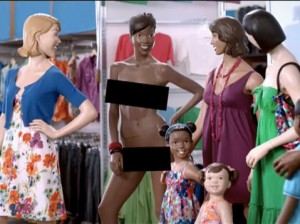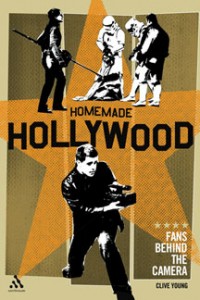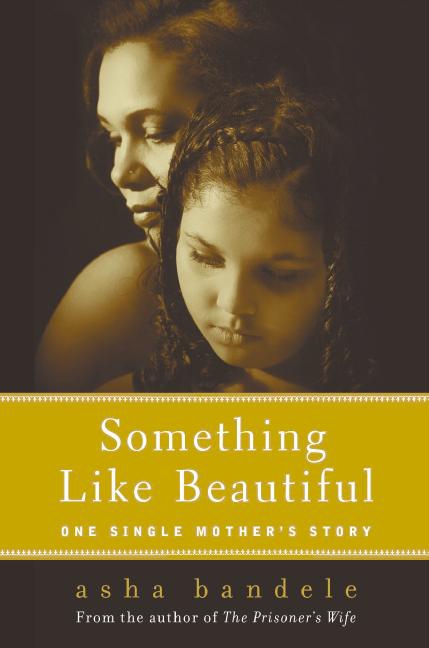
Educate and excite, inform and infuriate.
September 11th, 2009 — Crime, Government, History, Terrorism

March 23rd, 2009 — Advertising, Fashion, History, Media, Race
So wrote Leroy Colson of Detroit MI this past Friday, in an e-mail to MEDIA ASSASSIN. The Lord and Taylor ad to which he refers, above, shows two models wearing pink, $150 Ellen Tracy trench coats.
Well, rather, one of them—the white one facing the camera—wears the coat. The other one—the Black one with her back to you—can’t help flashing a white man walking by with two dogs, both of which, if you look closely, have their eyes punningly trained on her putty-tat. The auburn-colored chow is even tugging like he’s gonna run after it.
 Colson tipped me to this image after he read this past Thursday’s post, “Are There Racists at Old Navy, or Do They Think That We’re Dummies?” That piece described what I perceived as the underlying racial code of the current Old Navy “Mid-Town Flash” commercial.
Colson tipped me to this image after he read this past Thursday’s post, “Are There Racists at Old Navy, or Do They Think That We’re Dummies?” That piece described what I perceived as the underlying racial code of the current Old Navy “Mid-Town Flash” commercial.
It’s the one in which a Black store mannequin, above right, has her dress ripped off, leaving her, except for matching black bars, naked before her co-mannequins, as the incident is played for laughs, including her own.
Exactly what are the chances that a random individual, reading an article critiquing the public racial display of the nude Black female body, would, that same day, be sent another, unrelated ad, also racially displaying the nude Black female body in public? (By racial, I mean anything said or done that involves white people with non-white people.)
Maybe the chances are high. Perhaps having noticed such an ad, a viewer’s heightened attention might readily be drawn to another different one. But, hey: Are there that many of these around? Is this a sub-category? I mean, we’re not talking about something akin to the millions of spreads featuring pictures of, say, mothers gently feeding their babies, here, right?
 Oops: I spoke too soon, suddenly recalling clothing maker Benetton’s notorious 1989 ad, right, something the company called part of its “campaign for equality between black and white,” proudly noting that, while controversial, it “represents the most-awarded image in Benetton’s advertising history.”
Oops: I spoke too soon, suddenly recalling clothing maker Benetton’s notorious 1989 ad, right, something the company called part of its “campaign for equality between black and white,” proudly noting that, while controversial, it “represents the most-awarded image in Benetton’s advertising history.”
Clothing, white customers, Black women’s bodies: There’s almost something antebellum about the mix. How much of this sort of advertising exists? Why does it? Why does it always involve a Black woman being eyed by a white man—or in this case, suckling one—but never the reverse? I’m just asking those questions rhetorically. I’m Black, and, like Thulani noted in her comments, I know that
If a black kid had ripped the dress of a “white” mannequin, it would have [been] read as hostile in a racial way but it would not evoke many similar images from the past– there is no tradition of exposing white women’s bodies on the slave block. [Eds. note: Though, clearly, the slave block and suckling white infants are deeply intertwined.] … If the company meant to imply that the dresses were so cute the customers were ripping them off the mannequins, having them all ripped would have made the point in a non-racialized way.
In other words, there’s a relationship between what’s not permitted in reality and what’s not permitted symbolically, and the reverse is also true. Which was my original point: I believe the line from the auction block to the display stand is unbroken.
So, while I can’t prove they’re directly related, for example, it’s not odd to me that, that, in a country which tends towards these kinds of displays, a 2000 Congressional report found that “Black women were nearly twice as likely to be strip-searched on suspicion of smuggling drugs as white men and women.”
In any event, it’s fascinating the response last week’s post provoked. Besides the comments, perhaps the best indicator of the nerve it hit is that, on the day it went out, twenty of the people following me on Twitter quit doing so. (My followers automatically get tweets linking them to each day’s new MEDIA ASSASSIN post.)
Twenty is far more than have ever canceled me in one day. (The highest before that was seven.) In fact, twenty is more than half of all my Twitter unfollows to-date. Hopefully, most of them will come back when they see this post.
March 20th, 2009 — DVD, Film, History, NONFICTION, Sex
“Relax yourself, girl / Please settle down….”
I may have finally cleared up for you what Q-Tip was actually saying (he told me himself) on the chorus of A Tribe Called Quest’s hit 1993 single, whose title I’ve also lifted for today’s post. But that track’s hook also summarizes the sentiment which drove the development of a medical implement that, today, is a common sexual aid: The vibrator.
In the 19th century, doctors were commonly diagnosing “hysteria” in female patients, a condition marked, according to historian Rachel P. Maines, in her book, The Technology of Orgasm, as characterized by ”anxiety, sleeplessness, irritability,  nervousness, erotic fantasy, sensations of heaviness in the abdomen, lower pelvic edema and vaginal lubrication.” Hysteria was treated by inducing “paroxysm” in the patient, massaging her genitals until this state was reached. Manual methods, like the water massage technique, illustrated above, were applied. The development of early steam- or manually-powered vibrators, though, enabled doctors to stop using their hands and fingers for this task, while electric vibrators, such as this jackhammer-looking model, above right, made the process even more efficient.
nervousness, erotic fantasy, sensations of heaviness in the abdomen, lower pelvic edema and vaginal lubrication.” Hysteria was treated by inducing “paroxysm” in the patient, massaging her genitals until this state was reached. Manual methods, like the water massage technique, illustrated above, were applied. The development of early steam- or manually-powered vibrators, though, enabled doctors to stop using their hands and fingers for this task, while electric vibrators, such as this jackhammer-looking model, above right, made the process even more efficient.
If you’ve just read the previous paragraph in semi-disbelief, then said to yourself, “Hold up: In the 1800s, people were going to the doctor so he could get you off?”, you’re halfway there. Most people today would recognize “hysteria” as feminine sexual arousal. By categorizing it as an illness, however, Victorians avoided messy and uncomfortable discussions about the complexity of female sexuality and desire, relegating those discussions to the physician’s office, where they were, subsequently muted through categorization of the woman’s horniness as an illness. (There was no male equivalent of hysteria.) Argue producer/directors Wendy Slick and Emiko Omori, in their documentary PASSION & POWER: The Technology of Orgasm (a lot of title-borrowing today), hysteria “was a disease manufactured by doctors creating a lucrative clientele and a mutually camouflaged procedure that satisfied both” doctors and their patients.
Wendy Slick is a guest today on my WBAI-NY / 99.5 FM radio show, NONFICTION, this afternoon, Friday, March 20, at 2 pm ET.
 But first, we’ll also talk with author Clive Young, whose new book, Homemade Hollywood: Fans Behind The Camera, right, traces another history: That of the so-called “Fan Film revolution—an underground movement where backyard filmmakers are breaking the law to create unauthorized movies starring Batman, James Bond, Captain Kirk, Harry Potter and other classic characters,” ones “which copyrights and common sense would never allow.” I wrote about Star Wars fan films for the much-lamented PREMIERE magazine, back in 2001, so I’m looking forward to the conversation.
But first, we’ll also talk with author Clive Young, whose new book, Homemade Hollywood: Fans Behind The Camera, right, traces another history: That of the so-called “Fan Film revolution—an underground movement where backyard filmmakers are breaking the law to create unauthorized movies starring Batman, James Bond, Captain Kirk, Harry Potter and other classic characters,” ones “which copyrights and common sense would never allow.” I wrote about Star Wars fan films for the much-lamented PREMIERE magazine, back in 2001, so I’m looking forward to the conversation.
You can hear Wendy Slick’s and Clive Young’s ideas by tuning in at 2 pm. If you’re outside of the New York tri-state, check out our stream on the web. If you miss the live show, dig into our archives for up to 90 days after broadcast.
March 19th, 2009 — Advertising, Fashion, History, Media, Race
“Images of Black women that are in fact ‘national, racial, and historical hallucinations’ have been ingrained into the collective conscience of the United states since slavery. Black women have been depicted either naked, generally in an ethnographic context, or as laborers, usually domestic, their social status playing a crucial role in the development of visual identity. With rare exceptions, representations of the Black woman in art and photography have followed these prescribed lines.”—Kimberly Wallace-Sanders, Skin Deep, Spirit Strong: The Black Female Body in American Culture (Ann Arbor: University of Michigan Press, 2003), p. 182.
“I ‘members when they put me on the auction block. They pulled my dress down over my back to my waist, to show I ain’t gashed and slashed up. That’s to show you ain’t a mean nigger.”—Lu Perkins, quoted by James Mellon, ed., Bullwhip Days: The Slaves Remember: An Oral History (New York: Avon Books, 1988), p. 292.
In his 1985 book on the Atlanta child murders, The Evidence of Things Not Seen, writer James Baldwin (1924-1987) spoke of the “ancestral, daily, historical truth of Black life in this country,” then paused to note that, in the context of the African-American experience, the words “ancestral and daily are synonyms.” That is, they have the same meaning.
 What Baldwin, right, meant by that is what Black people state when they, speaking of the same conditions, inelegantly say, “Samo, samo.” In other words, same old thing, nothing’s different in any meaningful way. “You try and get ahead and they change the rules.” Whatever Black people do, white supremacy merely adapts. Or, as I often urge, “Why would they change what works?”
What Baldwin, right, meant by that is what Black people state when they, speaking of the same conditions, inelegantly say, “Samo, samo.” In other words, same old thing, nothing’s different in any meaningful way. “You try and get ahead and they change the rules.” Whatever Black people do, white supremacy merely adapts. Or, as I often urge, “Why would they change what works?”
It is utterly fascinating to see how frustrating these contentions remain to many white people. Their notion of history is heroic; a series of climaxes that they, like chiseled, blood-spattered action heroes, have wrangled. (Baldwin, right, of course, knew this, and in the aforementioned quote added that “historical does not refer to that spotless mirror in which the bulk of White North Americans imagine they see their faces,” but the actual, true history that Black people have borne.)
 Of course, when it comes to action-packed heroics, nothing tops this past November’s election and inauguration, right, of the current president. It was an achievement which moved many white people to quickly declare the age of Obama “post-racial.” A greater number said, more generously, but no less absurdly, that, in the wake of seating a Black president, “America had changed forever.” Pundit after pundit, in kind, asserted America’s “maturity” with this act.
Of course, when it comes to action-packed heroics, nothing tops this past November’s election and inauguration, right, of the current president. It was an achievement which moved many white people to quickly declare the age of Obama “post-racial.” A greater number said, more generously, but no less absurdly, that, in the wake of seating a Black president, “America had changed forever.” Pundit after pundit, in kind, asserted America’s “maturity” with this act.
Doesn’t having white people write their own absolution preserve white supremacy as a system? All of this, to me, had the quality of, after a home invasion and robbery, agreeing to let the thief fill out one’s insurance claim and police report. At the very least, one can agree that having the people who have victimized you quantify your mistreatment invokes a sizable conflict of interest.
Though all of the above is deeply relevant, none of this was on my mind Tuesday night, when, while watching American Idol, I saw an Old Navy commercial, titled “Mid-Town Flash,” below, in which a white actor, with one brisk move, strips off a Black female mannequin’s dress, leaving the figure, above, save for modesty bars, completely naked, smiling, and being curiously observed by her fellow mannequins, or “supermodelquins,” as the group are called in the corporation’s series of ads.
February 17th, 2009 — History, Race
 Photographer Delphine Fawundu-Buford is a smart, worldly woman, with a masters degree from NYU and solid commercial assignments. (Her picture of asha bandele and bandele’s daughter, Nisa, forms the cover of the author’s new book, Something Like Beautiful: One Single Mother’s Story, right, for example.)
Photographer Delphine Fawundu-Buford is a smart, worldly woman, with a masters degree from NYU and solid commercial assignments. (Her picture of asha bandele and bandele’s daughter, Nisa, forms the cover of the author’s new book, Something Like Beautiful: One Single Mother’s Story, right, for example.)
But she’s also quite youthful. So, as she’d not heard of it before, it was bracing to connect to her horror and outrage, in a recent post for her blog, And She Don’t Stop. There, she describes how, last year, she encountered an archival photograph, then, subsequently, what seems like the entire history of racist ephemera, above, depicting African-Americans, especially infants, as alligator chum.
February 3rd, 2009 — Art, History
I’m as interested in correcting fake history as the next guy, and, sure, in her paintings, Martha Washington looks like she was never any other age than 70.
But in this image created by portraitist Michael Deas, above, oddly enough, the mother of our country looks like one in the endless parade of 24-year-old white trust fund chicks who overpopulate New York City.
This likeness, says the artist’s web site,
was based primarily on a computer generated age-regression image created by an Louisiana State University forensic anthropologist. Contrary to popular belief, Martha Washinton was not a dowdy matron, but a witty, astute, and ardent patriot who followed her husband into battle, even encamping with him during the bitter winter at Valley Forge. The portrait is the Nation’s first glimpse at what Martha Washington looked like prior to her marriage to her famous husband.
I’m gonna send ol’ Martha a query letter and some of my clips.
January 20th, 2009 — History, Politics, Race
The cover of The Nation magazine‘s February 2 edition, above, depicting the inauguration of Barack Obama as it would take place were America, and not God alone, truly just.
Go to The Nation‘s specially prepared key for the identities of all persons portrayed.
Art by John Mavroudis.
December 29th, 2008 — Hip-Hop, History, Pop Culture
I’m not a big rare record collector, as a) I’m not a d.j. or a producer, b) a lot of music is on CD or p2p networks, and c) I bought most of what I really love when it originally came out. (Well, O.K.: I didn’t purchase World’s Famous Supreme Team’s “Hey D.J.” 12″ (the track’s glorious video, here), a Jean-Michel Basquiat “test pressing sleeve” version of Rammellzee vs. K-Rob’s “Beat Bop,” or perfection itself—Endgames’ “Ecstasy” instrumental—but hey, I can’t be everywhere at once.)
However, I did once gleefully fork over significant cash to an unseen Brit for a beautifully preserved, 12″ copy of the Russell Brothers’ 1983 electro-funk masterpiece, “The Party Scene,” above. The reverb-laden, synth-spazzed track’s first minute-and-a-half have always sounded, to my ears, like something big, dangerous, and powerful being turned on, then warming up; like, say, the Large Hadron Collider if it was being run by Parliament-Funkadelic.
If you know what I mean, or loved this disc during your Back In the Days days, this chilly YouTube link will, paradoxically, warm your cockles. The rest of y’all, take your chances. Play loud, as always.
October 17th, 2008 — Controversy, History, NONFICTION, Photography, Race, Sports
It may be the most iconic moment in all of sports history. Forty years ago, this week, U.S. athletes Tommie Smith and John Carlos, center and right, above, having placed gold and bronze medals, respectively, in the 200m dash at the 1968 Olympics in Mexico City, went to the center of the field to accept their honors.
They stepped onto the podium, shoeless, wearing black socks, and, as “The Star-Spangled Banner” sounded forth, lowered their heads, and raised gloved, Black power fist salutes to the heavens. (LIFE magazine photographer John Dominis snapped the powerful image.)
The reaction was immediate and passionate. The stadium audience hotly booed the duo as they walked away, and the International Olympic Committee, which governs the games, expelled the athletes, as their protest made headlines around the globe.
In her 2002 book, Not the Triumph but the Struggle: The 1968 Olympics and the Making of the Black Athlete, historian Amy Bass deeply diagrams the backdrop against which the protests took place, but, even more, shows how the act powerfully redefined the concept of the Black athlete in the popular imagination.
Dr. Amy Bass is the guest, today, on my WBAI-NY / 99.5 FM radio show, NONFICTION, this afternoon, Friday, October 17, 2 pm ET.
If you’re outside of the New York tri-state, you can check out our stream on the web. If you miss the live show, check out our archive for up to two weeks after broadcast.
October 16th, 2008 — History, Politics
Have you noticed not a single media outlet has yet raised a question about John McCain’s characterization of segregation as “the worst chapter in American history”?